#gond art drawing
Text
Reviving the Legacy of Gond Artistry: Gond-inspired Serveware Collection
Discover the enchanting revival of Gond artistry with our exquisite serveware collection. Inspired by the vibrant and intricate Gond tribal paintings, each piece is a masterpiece of craftsmanship. Experience the fusion of traditional art and modern design, bringing a touch of cultural heritage to your dining table. Indulge in the rich storytelling and symbolism of Gond art, while elevating your dining experience with our stunning serveware. Explore our collection and bring the legacy of Gond artistry into your home today.

#art indie drawings#buy gond#folk art paintings#folk art pictures#Gond art#gond art india#gond art painting#gond painting#indian art prints#indian arts and crafts#indie art ideas#What is Gonda art?#gond art drawing#beautiful gond art#gond art images#gond tribal art#what is gond art#gond art designs#gond folk art#gond art history#gond art origin#gond artist
0 notes
Text

A Goblin artificer of Gond for your next Faerun campagin! Like what I do and want to support me? Why not become a Patron: patreon.com/joephilliactheblack
Or buy me a coffee: ko-fi.com/A2581GB3
Watch on TikTok: https://www.tiktok.com/@joephilliactheblack/video/7348784273807150369?is_from_webapp=1&sender_device=pc&web_id=7343273404871165473
#goblin#goblincore#steampunk#dnd#dungeons and dragons#dungeons and drawings#faerun#artificer#gond#monster girl#ibis#tiktok#my art#digital art#artists on tumblr
4 notes
·
View notes
Text
"can you draw a portrait of this guy" what if i killed myself in front of you
#BEFORE MY MUTUALS GET WORRIED.#situation is we're having an exhibit in our school#and im in the art group#(that was the thing i was doing the madhubani art for a while ago)#i've done 2 more pieces (gond and cheriyal) other than that#one tribal mask#and one warli art#and now. the teachers from other subject came to our group and was like “can you draw us a protrait of this scientist”#and my friend hemmed and hawwed a bit#before finally going “diya you can draw those realistic portaits right”#i have two folk art pieces and one warli art piece#and a tribal mask to finish#in addition to a math test this tuesday#no i do not have the fucking time#later i asked them why they said me specifically#bc the only art of mine they've seen are the cartoony stuff i draw for fun#and they were like “idk you look like the kind of person who can do that”#and i. UITHDFJKSL. YOURE RIGHT BUT STILL#txt
2 notes
·
View notes
Text
Landscape, Scenery Paintings at Best Price
This is a beautiful sunrise landscape paintings created by Anuradha Saxena. The painting is made with acrylics on a canvas board and measures 16 inches in width and 12 inches in height. The painting has been varnished for care and protection and is perfect for wall decor. The vibrant colors used in the painting capture the beauty of the sunrise and the natural landscape. This painting would make a wonderful addition to any art collection or home decor.
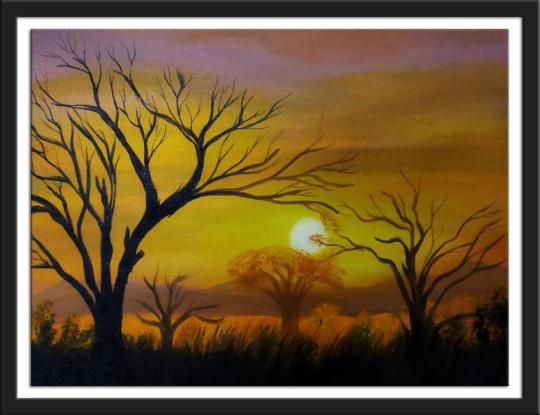
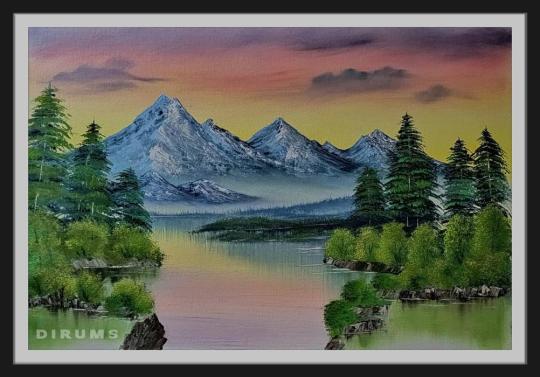
#Landscape Painting#Ganesha drawing#Ganpati painting#Indian art culture painting#Lord Ganesha Painting#Handmade Painting#Folk Art Painting#Gond Art painting#Online Art Gallery#Selling Paintings Online#Indian Traditional Painting#Paintings for Bedroom#digital art#Buy Acrylic Paintings#Online painting sale#Indian artworks#original art#Abstract paintings#Modern painting#modern art#Maa durga paintings#Durga paintings#Drawings for Sale
0 notes
Note
Thought Experiment!
Imagine if there was an anon with nothing but MSPaint, no art knowledge and the will of a dying star....
What does Asheera look like if someone would want to draw her? And if I maybe so bold to ask.....as detailed as you'd deem reasonably possible?
Here's some art that a very lovely person gifted me (artist tagged there) You can use that for reference if you'd like, since she matched exactly what I had in mind!
And I'm 99% sure the "oc: asheera" tag has a WIP Wednesday post where I went into detail vis-a-vis height/weight/eye & hair color. But for reference if you can't find that post:
Dark olive green skin
Black hair with light streaks of blue (thanks for that, Gond)
Slightly reddish brown eyes ("ruddy" in fics)
I'd be ecstatic to have any art of her - sketches, masterpieces, whatever. It would be a cherished gift. I'd just ask, in general for any other wild minds, to tag me and list me as the creator of the OC if any art is posted separately from this blog 💜
2 notes
·
View notes
Photo

Watercolour on paper. #nutankishor @beingnutan_ #art #artwork #watercolours #watercolour #painting #portraiture #nutankishor #portrait #drawing #artoninstagram #instaart #artstudio #contemporaryart #aquarelle #arte #instagood #watercolorpainting #canson #overworked_but_underfucked #baster #tribe #chhatisgarh #gond #women #women #aamchobastar #adivasi #gond #girl #girls #she #watercolours #watercolourstudy (at India) https://www.instagram.com/p/CoRw24ivYO4/?igshid=NGJjMDIxMWI=
#nutankishor#art#artwork#watercolours#watercolour#painting#portraiture#portrait#drawing#artoninstagram#instaart#artstudio#contemporaryart#aquarelle#arte#instagood#watercolorpainting#canson#overworked_but_underfucked#baster#tribe#chhatisgarh#gond#women#aamchobastar#adivasi#girl#girls#she#watercolourstudy
12 notes
·
View notes
Text
10 Aspects of Cheriyal Paintings
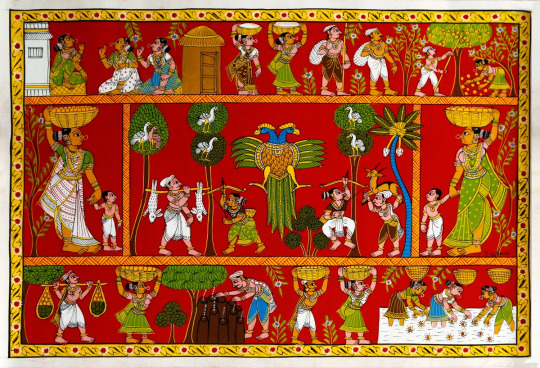
Have you heard about Cheriyal Paintings? If you are an Indian folk art aficionado, you might have; but most of us, unfortunately, do not know much about the art form. In this blog, let’s try learning ten aspects of this Cheriyal painting tradition.
What are Cheriyal Paintings?
Cheriyal paintings are long narrative scroll paintings that serve as visual aids to a musical storytelling tradition. A conventional Cheriyal scroll is vertical and is divided into different frames, with each frame depicting a scene from the tale that is being presented. Since these scrolls are meant to be rolled when not in use, they are made with fabric. Traditionally, a khadi cloth is used as the base for these paintings.
Where do they come from?
The name that the art form is known by today, i.e., Cheriyal, is derived from the town it is currently practised in. Cheriyal is a town in the Siddipet district of Telangana, India. The practice of the art form is much more limited than it was previously. Initially, these paintings were known as nakash or naqash, which translates to a drawing or a sketch.
Who are the people who are associated with these scrolls?
In addition to the previous aspect, the people involved in the creation of these traditional nakash or Cheriyal paintings, are a community known as the Nakashis. Other than this community, there is another important group of individuals associated with this tradition. It is important to note that the actual purpose of these scrolls was to serve as visual aids when a storyteller narrated a particular folklore or mythological story in the form of a song. This community of balladeers is referred to as kaki padagollu. They travel from village to village narrating these stories.
How old is the Cheriyal painting tradition?
As mentioned before, Cheriyal paintings were originally called nakash. Research suggests that these initial pieces were a little different from the ones created today, and are a result of cultural amalgamation. It is believed that the art form and technique of nakash came into the Indian subcontinent from Persia during the reign of the Mughals around the 16th century CE. Hence, making the Cheriyal painting tradition around 400 years old.
What themes do these paintings usually revolve around?
The most prominent themes that are featured in Cheriyal paintings are the stories from Hindu epics like the Ramayana and the Mahabharata, and also the Puranas. For example, below is an example of a Cheriyal painting depicting the stories from the life of the Hindu deity Krishna.
Other than these religious and mythological tales, these paintings also depict the social life, cultural practices, and festivities of the local communities. In the Cheriyal painting below, instances from day-to-day life in a rural setting are portrayed.
What are commonly noticed motifs and patterns in Cheriyal paintings?
Since religious tales are a popular theme in these scrolls, Hindu religious iconography is one of the most visible motifs in this art form. Moreover, flora and fauna are commonly painted on these scrolls too. Other than these, brightly coloured borders - both, at the edges of the scroll and in between the frames - with floral patterns are one of the most identifiable features of Cheriyal paintings. A bright red background too is a given in almost all Cheriyal works.
What paints are used in these paintings?
Like all traditional folk art forms, Cheriyal paintings too use only naturally sourced colours. Most of the pigments used in these paintings are mineral based, i.e., they are obtained from coloured stones. These stones are crushed into a fine powder and mixed with a natural binder and water. The natural binder used is gum arabic, locally called tirumani gond. This mixture is prepared with extreme attentiveness to make paint that is of the right saturation and has the ability to stick to the cloth base.
What tools are used by Cheriyal artists to make these paintings?
Paintbrushes are the only tools which are used by Cheriyal artists to draw, paint, and add details to their artworks. Traditionally, these paintbrushes were made using squirrel hair because of how fine the artists could paint with them. However, today this practice has been replaced by market-available synthetic brushes.
New adaptations? New trends?
With changing times, the popularity of Cheriyal scrolls and the accompanying musical narrative tradition faced a decline. To sustain themselves, these artists have adapted themselves to the changing needs and tastes. Today, the size of these scrolls has been minimised and the number of frames per painting has been decreased too. This is because these paintings are now used more as decorative pieces in households, rather than as storytelling aids.
Another innovation of the Cheriyral artists is also the minimising of the Cheriyal masks. Originally, these masks were worn by the storytellers to give their audiences a more vivid experience. But as mentioned before, the decline in the associated storytelling tradition led to a decline in the demand. Today, these mini Cheriyal masks serve as decorative items.
Some Cheriyal artists also experiment with newer subjects and depict contemporary issues.
Where can you learn this art form?
Now, if you really got interested in these Cheriyal paintings, we encourage you to check out Rooftop! This online platform provides daily workshops on different traditional art forms from India, and Cheriyal painting workshops do come up every now and then. Rooftop also has Maestro Courses, where authentic folk artists give lessons to anyone interested. Cheriyal art form is one of the upcoming courses there!
You can also check out our Instagram or download the Rooftop App from GooglePlay or AppStore.
Source: https://medium.com/@rooftopapp/10-aspects-of-cheriyal-paintings-39bf5f73a400
5 notes
·
View notes
Text
Warli Paintings: Exotic form of simple art
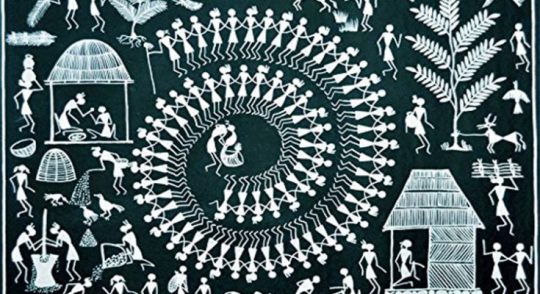
A Picture is a ballad without words. The Warli Art shape is the pictorial dialect used to speak to the tribal people craft of the early tribes of Thane area, Maharashtra.
It portrays the dancing, chasing and development of land with the tribal hovels made in a dark, mustard yellow or the white foundation. Keeping in mind the end goal to educate these structures to the understudies, we embrace a particular showing strategy, so that even non-craftsmen can paint the lovely warli. All these and more can be investigated about the antiquated India.
The word “Warli” originates from “warla” which implies a real estate parcel or a field despite being in such closeness of the biggest city in India, Warli tribesmen are as yet not urban. Warli Art was first found in the mid-seventies. While there are no records of the correct beginnings of this workmanship, its underlying foundations might be followed to as right on time as the tenth century AD. Warli is the distinctive articulation of day by day and get-togethers of the Warli tribe of Maharashtra, utilized by them to enhance the dividers of town houses. This was the main method for transmitting fables to other people who are not familiar with the composed word.
These works of art don’t portray fanciful characters or pictures of divinities, however delineate social life. Pictures of individuals and creatures, alongside scenes from everyday life are made in a free cadenced example. Painted white on mud dividers, they are entirely near pre-notable buckle artistic creations in execution and as a rule delineate scenes of human figures occupied with exercises like chasing, dancing, sowing ,collecting, going out, drawing water from well, drying clothes.
It fundamentally comprises of geometrical examples
1. Circle: speaking to the sun and the moon
2. Triangle: triangle got from mountains and pointed trees
3.Square: showing a consecrated walled area or a land parcel. So the focal rationale in every custom painting is the square
These geometric figures are consolidated to shape lovely examples .Like two summits of triangles are combined to frame a human figure.
Warli canvases on paper have turned out to be exceptionally prevalent and are presently sold all over India. Today, little compositions are done on fabric and paper however they look best on the w alls or as colossal wall paintings that draw out the tremendous and otherworldly universe of the Warlis. For the Warlis, convention is still clung to however in the meantime new thoughts have been permitted to leak in which encourages them to confront new difficulties from the market.
Learn this simple art, find designs & explore the world of warlis at Penkraft through our workshop.
Penkraft conducts classes, course, online courses, live courses, workshops, teachers’ training & online teachers’ training in Handwriting Improvement, Calligraphy, Abacus Maths, Vedic Maths, Phonics and various Craft & Artforms — Madhubani, Mandala, Warli, Gond, Lippan Art, Kalighat, Kalamkari, Pichwai, Cheriyal, Kerala Mural, Pattachitra, Tanjore Painting, One Stroke Painting, Decoupage, Image Transfer, Resin Art, Fluid Art, Alcohol Ink Art, Pop Art, Knife Painting, Scandinavian Art, Water Colors, Coffee Painting, Pencil Shading, Resin Art Advanced etc. at pan-India locations. With our mission to inspire, educate, empower & uplift people through our endeavours, we have trained & operationally supported (and continue to support) 1500+ home-makers to become Penkraft Certified Teachers? in various disciplines.
4 notes
·
View notes
Text

#LearnOnline with #Penkraft - #GondArt!
Penkraft Online Gond Art course is a 20-hour, structured, module-based, certified course to be completed in 25 days.
During this course, the student learns the nuances of Gond Art starting with the basic principles, and colors, and then learns to draw the design on various surfaces like cartridge paper, canvas, MDF clock, and cloth bag. The student also learns to add dots and dashes to impart a greater sense of movement and to increase the amount of detail.
Throughout the course, we keep providing tips and tricks to make your experience rewarding and your knowledge of this art thorough!
The fee for this course is INR 1,499/- Material needed for the course is supplied FREE of cost and delivered to your address.
To know more about the course, to watch the demo course video, and to subscribe to the course, click here -
For queries/assistance, please contact us at +91 73040 44598.
0 notes
Text
Gond Art on Kids' Clothing: A Gateway to Education and Cultural Heritage
When picking out clothes for your child, it's important to look beyond just comfort and style. The clothes they wear can also serve as an educational tool and a connection to their cultural roots. Gond Art on children's clothing offers more than just vibrant designs; it introduces your child to a rich cultural legacy and helps sustain an ancient art
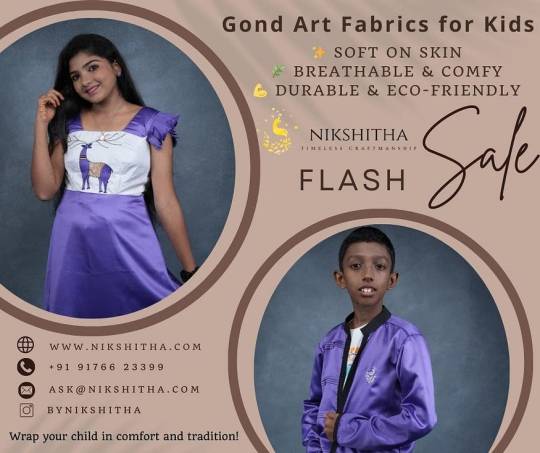
Why Gond Art Is Important for Kids
Gond Art is a traditional art form from the Gond tribe, one of India's largest indigenous communities. Known for its bright colors, detailed patterns, and symbolic meanings, Gond Art is much more than just a visual treat. By incorporating Gond Art into your child's wardrobe, you're offering them an opportunity to learn and appreciate a unique cultural heritage.
Educational Benefits of Gond Art in Children's Fashion
Cultural Roots: Building a Strong Connection
Gond Art acts as a bridge between your child and their cultural background. Wearing clothing featuring these traditional designs helps your child become familiar with the art and its stories, fostering a deep sense of identity and pride in their heritage.
Art as Storytelling: The Lessons Behind the Designs
Each Gond Art piece tells a story, often drawing from nature, folklore, and tribal life. For instance, the deer, a frequent motif in Gond Art, stands for grace, beauty, and the importance of living in harmony with nature. By understanding these symbols, children can learn the values and lessons embedded in the art.
Heritage Preservation: Keeping a Tradition Alive
Choosing Gond Art for your child’s clothing contributes to the preservation of a tradition that has been around for thousands of years. This helps ensure that the art form and its cultural significance are passed down to future generations.
Art Appreciation: Encouraging Creativity
Introducing your child to Gond Art helps them develop an appreciation for different forms of artistic expression. This exposure can spark creativity and foster a love for art that extends beyond the classroom, enriching their overall education.
How to Add Gond Art to Your Child’s Wardrobe
Gond Art on children's clothing is more than just a fashion choice; it's a way to connect your child with their cultural roots. By choosing these designs, you're giving your child the chance to learn, appreciate, and take pride in a rich cultural tradition while wearing something truly unique. This not only adds educational value to their wardrobe but also plays a vital role in keeping this ancient art form alive for future generations.
Discover more about our exclusive collections that celebrate Indian craftsmanship and heritage. Visit www.nikshitha.com today to find the perfect premium kidswear for your little ones!
0 notes
Text
The Art of Storytelling
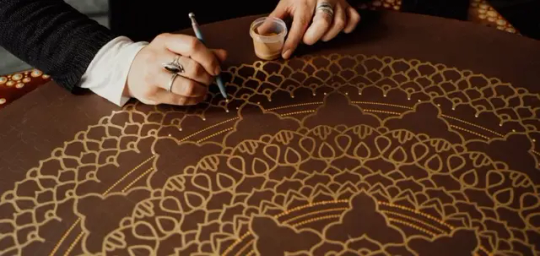
In this article, we embark on a journey to explore the enchanting world of Indian folk and tribal art, where stories come to life through brush strokes, intricate designs, and mesmerizing patterns.
The Mosaic of Folk and Tribal Art
India’s folk and tribal art forms are as diverse as its people and traditions. From the intricate Madhubani paintings of Bihar to the exuberant Warli art of Maharashtra, the flamboyant Pattachitra of Odisha to the vibrant Gond art of Madhya Pradesh, the canvas of Indian folk art is kaleidoscopic. Each form carries a unique story, a slice of history, and a piece of life.
These art forms are not confined to canvas or paper; they adorn walls, floors, and even textiles. They narrate tales of daily life, rituals, myths, and legends with a profound connection to nature and the spiritual world. It is through these art forms that generations have preserved their cultural identity, transcending language barriers and the sands of time.
Folk and Tribal Artists as The Storytellers
The custodians of this rich tradition are the skilled artists who create these masterpieces. Often hailing from marginalized communities and remote villages, these artists connect profoundly with their art. They learn from their elders, observing and imitating the techniques passed down through generations. Their art is not just a livelihood but a means of preserving their heritage.
Artists like Jangarh Singh Shyam, Jivya Soma Mashe, and Bhuri Bai have taken their traditional Gond and Warli art to international platforms, garnering recognition and acclaim. Their stories are a testament to the power of art in transcending borders and creating a global impact.
Visual Stories of Daily Life
Folk and tribal art celebrate every day, capturing the mundane in a mesmerizing manner. Scenes of rural life, agriculture, and the bustling village market come alive through these art forms. The portrayal of women fetching water from the well, farmers toiling in the fields, or tribal celebrations and rituals all encapsulate the essence of rural India.
For instance, Warli’s art, characterized by its rudimentary style and simple geometric shapes, depicts scenes of marriage, harvest, and the connection between humans and nature. These visual narratives often represent the artist’s perspective on life, embodying their worldview, aspirations, and reverence for their surroundings.
Myths and Legends on Canvas
Myths and legends, handed down through generations, find a vivid expression in folk and tribal art. These art forms are a repository of ancient stories, many of which revolve around gods, goddesses, and mythical creatures. Through intricate detailing and bold strokes, artists breathe life into these tales.
In Odisha’s Pattachitra, one can witness the epic stories of Lord Jagannath, Krishna, and other Hindu deities. These paintings often adorn the walls of temples, adding a sacred dimension to their artistic beauty. The blending of spirituality and art is a remarkable feature of these art forms.
Nature as Muse
Nature has always been a recurring theme in folk and tribal art. Artists draw inspiration from their immediate surroundings, showcasing the flora and fauna that are an integral part of their lives. Trees, birds, animals, and the elements are meticulously depicted, reflecting the harmony and dependence between humans and nature.
The Santhal tribes of West Bengal, for example, are known for their depictions of nature and animals in their Sohrai and Khovar art. Through vibrant patterns and bold colors, they express their deep connection to the earth and the creatures that share their habitat.
Reviving the Past, Paving the Future
While these art forms have a rich and timeless history, they have not remained stagnant. In an era of globalization, these art forms have evolved and adapted to new mediums and audiences. Artists are experimenting with modern materials, such as canvas and acrylics, to cater to a broader market.
Non-governmental organizations and government initiatives have played a significant role in preserving and promoting folk and tribal art. They provide artists with training, exposure, and access to global markets, ensuring these traditions thrive.
Blog: https://theknowledgereview.in/the-art-of-storytelling/
Credit: https://theknowledgereview.in/
#EducationLeadersinIndia#BestEducationalMagazineinIndia#TopEducationMagazine#EducationalMagazineinIndia
1 note
·
View note
Text
How to Choose the Best Indian Painting for Your Home’s Hallway
Introduction
Paintings are a great way to add colours to dull hallways, transforming them into vibrant spaces that tell a story. Imagine walking into your home and being greeted by the rich heritage of Indian art, the intricate details of traditional Indian paintings, or the bold strokes of modern art. Each painting is more than just a decorative piece; it’s a conversation starter, a reflection of your taste, and a statement about your love for art.
In this blog, we will guide you on how to choose the perfect Indian art painting that not only enhances the beauty of your hallway but also resonates with your personality. So, let’s embark on this colourful journey together!
Types of Indian Paintings[1] [2] [3]
Madhubani Paintings: Originating from the Mithila region of Bihar, Madhubani paintings are characterised by their eye-catching geometric patterns and vibrant colours. They often depict scenes from Hindu mythology, nature, and everyday life. In a hallway, a Madhubani painting can add a burst of colour and a touch of tradition. Its intricate details can captivate visitors and spark conversations.
Warli Paintings: Warli paintings come from the tribal regions of Maharashtra. They are simple and elegant, using a basic circle-and-triangle pattern to depict various scenes of social and cultural life. A Warli painting in your hallway can bring a sense of calm and simplicity. Its minimalistic design can complement modern decor while adding a hint of rustic charm.
Gond Paintings: Gond paintings are a form of tribal art from Madhya Pradesh. They are known for their rich detail and bright colours. Gond paintings often depict scenes from folklore and the natural world. A Gond painting can make your hallway come alive with its vivid imagery and storytelling. It can serve as a striking centrepiece that draws the eye.
Rajasthani Miniature Paintings: Miniature paintings from Rajasthan are renowned for their intricate detail, vibrant colours, and elaborate themes, often depicting royal life, love stories, and scenes from Hindu epics. A Rajasthani miniature painting can add a royal touch to your hallway. Its rich colours and detailed imagery can create a luxurious feel.
Pattachitra Paintings: Pattachitra is a traditional painting form from Odisha, known for its intricate details and mythological narratives, especially inspired by Jagannath and Vaishnava sects. A Pattachitra painting can infuse your hallway with a divine touch. Its spiritual themes can create a serene and peaceful ambience.
Choosing the Right Painting
Choosing the right Indian painting for your hallway is a personal journey that reflects your taste, personality, and the ambience you want to create. Here are some factors to consider:
Size: The size of the painting should be in proportion to your hallway. A large modern art painting can be a statement piece in a spacious hallway, while smaller paintings can create a gallery effect in a narrow space.
Colour Scheme: The colours in the painting should complement the existing colour scheme of your hallway. You can choose a painting with contrasting colours to create a focal point or select one with similar tones for a harmonious look.
Style: The style of the painting should align with your home decor. If your home has traditional Indian decor, you might opt for Madhubani or Warli paintings. For a modern look, you could consider modern art paintings of abstract art.
Theme: The theme of the painting can set the mood for your hallway. Landscape oil paintings can bring a sense of tranquillity and nature to your home. On the other hand, paintings depicting scenes from Indian mythology can add a touch of culture and heritage.
Personal Resonance: Most importantly, the painting should resonate with you. It should be a piece that you love and enjoy, as it’s something you’ll see every day.
Best Indian Painting Suggestions
1. Buddha Blessing Hand Painting
2. Varanasi Ghaat Painting
3. Radha Krishna with Cows

Conclusion
Choosing the right Indian painting for your home’s hallway is an exciting journey that combines your personal taste, the aesthetics of your home, and the rich tapestry of Indian art. Whether you choose a vibrant Madhubani painting, a serene landscape oil painting, or a bold modern art piece, the right artwork can transform your hallway into a captivating gallery of your own.
0 notes
Text
Exploring the Rich Tapestry of Gond Art: A Dive into the World of Gond Paintings
Introduction:
Gond art, a traditional form of Indian tribal art, has gained recognition and appreciation on the global stage. Rooted in the rich cultural heritage of the Gond tribal community, these intricate paintings tell stories of nature, folklore, and spirituality. In this blog, we will delve into the captivating realm of Gond art, exploring its origins, techniques, and significance in today's art world.
I. Origins of Gond Art:
Gond art finds its roots in the Gond tribal communities of central India, particularly in the states of Madhya Pradesh and Chhattisgarh. The word "Gond" refers to both the tribe and their art form, which has been passed down through generations. The tradition of Gond painting is deeply intertwined with the tribe's connection to nature, myths, and daily life.
II. Unique Characteristics of Gond Paintings:
Vibrant Colors and Intricate Patterns:
Gond paintings are known for their vibrant and eye-catching colors. Artists use natural pigments and dyes derived from plants, creating a visually stunning array of hues. The paintings also feature intricate patterns and detailing, showcasing the artist's skill and attention to detail.
Depiction of Nature and Folklore:
Gond art predominantly revolves around nature and folklore. Animals, birds, and trees are recurring motifs, often depicted in a stylized and symbolic manner. The paintings tell stories of the Gond community's deep connection with the environment and their cultural narratives.
III. Techniques Employed in Gond Art:
Dot and Line Work:
Gond artists employ a unique technique of creating intricate patterns using dots and lines. The meticulous arrangement of these elements contributes to the overall aesthetics of the painting, giving it a distinctive look.
Nature-Inspired Imagery:
The artists draw inspiration from the natural world, incorporating flora and fauna into their compositions. The stylized representation of animals and plants adds a surreal and whimsical quality to Gond paintings.
IV. Significance in Today's Art World:
Cultural Preservation:
Gond art serves as a significant cultural identifier for the Gond community. In today's rapidly changing world, the preservation of this traditional art form is crucial in maintaining the cultural heritage of the tribe.
Global Recognition:
Over the years, Gond art has gained international acclaim, with exhibitions and collaborations showcasing the talent of Gond artists on a global platform. This recognition not only provides economic opportunities for the artists but also promotes cross-cultural understanding.
Conclusion:
Gond art, with its vibrant colors, intricate patterns, and cultural significance, stands as a testament to the rich artistic heritage of the Gond tribal community. As we appreciate the beauty of Gond paintings, let us also recognize the importance of preserving and celebrating the diverse traditions that contribute to the tapestry of global art.
0 notes
Text
Gond Art : A Folk Art Form with Beautiful Tribal Colours, Themes and Shapes
The Gond tribe originated in Madhya Pradesh, and their name comes from the word 'Kond,' which means "green mountain." While Gond art is mainly associated with Madhya Pradesh, it is also popular in Andhra Pradesh, Maharashtra, Chhattisgarh, and Odisha. The Government of India has taken steps to preserve the Gond art, aiming to support the artisans financially and inspire future generations. As a result, Gond art has gained popularity and is now showcased in international exhibitions, fetching high prices.
The Rich History of Gond Art
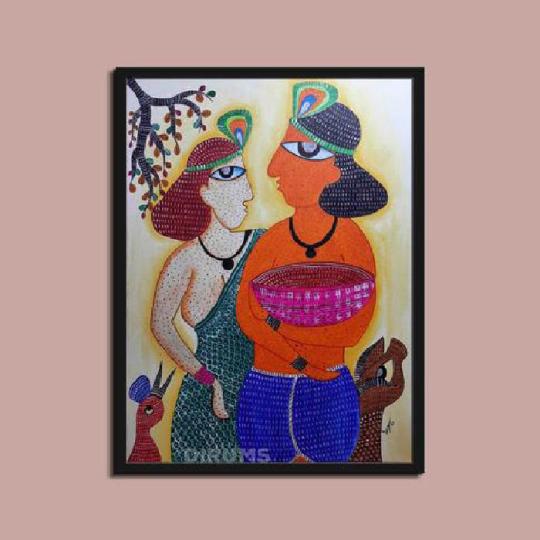
Gond people have been practicing painting and other art forms for more than 1400 years. They have a long tradition of making art on cave walls, dating back to the Mesolithic period. The Gonds believe that seeing beautiful images brings good luck, so they traditionally paint motifs, tattoos and images on the floors and walls of their homes. These images also serve to preserve and share historical knowledge and teachings.
Pradhan Gonds are known for their impressive skills in both art and music. In the 1980s, the director of the Bharat Bhavan Museum in Bhopal, J. Swaminathan, wanted to showcase urban and tribal art together. He sent his students to various villages in the Dindori district to find artists, and one of them was a notable painter named Jangarh Singh Shyam, who belonged to the dominant Gond community. Jangarh Singh Shyam was the first tribal artist to use canvas and paper for his artwork.
The Natural Themes of Gond Art

The Gond people believe that every element of nature, be it mountains, sky or trees, is the abode of a spirit. Hence recreating the forms of nature is done with reverence and worship of their sacred essence. These paintings serve as an example of the close connection of the Gond tribe with the spirit of nature. Gond paintings draw inspiration from the myths and legends of India. They also depict scenes from the contemporary life of the people. An elaborate narrative portrays abstract concepts involving feelings, dreams, and imaginative constructs. Since many Pradhan Gonds are accomplished musicians, their paintings often depict stories from their songs.
The most important subjects explored and depicted in Gond's paintings include birds, animals and mythological animals. Since the paintings also derive themes from the people's daily lives, the Mahua tree is an important subject. Considered the tree of life, the flowers, fruits, seeds and leaves of the Mahua tree serve many purposes for the tribe. Urban themes depict modern themes such as technology and automobiles. Folktales and local deities like Phulwari Devi, Jalharin Devi and Marahi Devi are culturally important.

The Exquisite Shapes of Gond Art
The style incorporated takes care that the lines, whether of the border or of the internal intricacies that form the subjects, immediately attract the viewer's attention. Dots and dashes accentuate the details with exquisite brilliance unique to Gond paintings. The inclusion of various geometric shapes and patterns, such as fish scales, water droplets and seed shapes, round out the expressive value of the art. A sense of motion is established through the curves and strokes of the lines, and so many critics have described it as an 'on line work.'
0 notes
Text
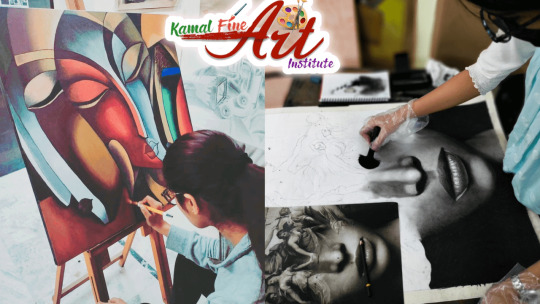
Kamal Fine Art Institute is a Prominent and Trusted Platform for Online Painting Classes. Live Painting Courses With Certified Teachers are Available at Kamal Fine Art Institute. Various Online Painting Courses are Available online Painting, Drawing, Art, Acrylic Painting, Sketching, Oil Painting, Portrait Painting, Canvas Painting, Watercolor Painting, Landscape Painting, Oil Pastel Painting, Charcoal Painting, Soft Pastel Painting, Gouache Painting, Abstract Painting, Tanjore Painting, Batik Painting, Miniature Painting, Madhubani Painting, Kalamkari Painting, Warli Painting, Gond Art Painting, Mandana Painting, and Mandala Painting For kids and Adults.
#onlinepaintingclasses#onlinepaintingcourse#bestfineartinstituteindelhi#bfaentranceexamcoaching#sketchingclassesindelhi
1 note
·
View note
Text
Indian tribal folk art- wall paintings
Hello there! Art of the form of communication and journaling even before the invention of words or numbers. Art ages all the way to Neanderthal man, Indian folk arts speak about the way of living and explains of aspect of people’s lives and status.
In this blog, I’d like to share my senses of various tribal wall folk arts that I’ve gained the knowledge from the art researcher Mr.Soujit Das.
Pithora

Pithora origins from the state of Madhya Pradesh and Gujarat. A salient feature of the pithora painting is the featuring of seven horses dedicated to their god ‘Pithora baba’. The name Pithora means 'god of the tribe’.
The purpose of this painting is to offer god the important necessity of people’s life I.e, grains in order to get blessed with flourishing wealth. These painting can be found in the walls of the hall as it considered to be a sacred part of the house.

The process of painting is considered to be sacred as well because they work has a guide to the household as they are painted only during special occasions like wedding and birth giving.
According to a tribal myth, rain began to fall shortly after a devotee made a vow to appease Pithora deva long ago when our planet was experiencing a drought. Then he organised the painting of Pithora devas on his house's walls. Since then, the painting has been started once desires are granted or challenges are overcome.
To know more about Pithora art use the link below.
Madhubani

Madhubani belongs to the tribal community of Mithila. This is considered to be some of the most political art forms around Indian as the way of art describes their social status.
Like every other folk art Madhubani also uses the colour from nature painted with wooden twigs and fingers. As one can see, Madhubani is believed to be given birth along with Sita from the mythology. It is also believed that Mithila painters are commissioned to paint at weddings of people holding higher statuses during the wedding season like Sita’s father Kinda Janak did during her wedding.
Only the people of high class were allowed to use colour in their painting and people from outskirts and under privileged were only allowed to draw in black and whites.


Only in recent years we’ve started appreciating this particular art.
Gond

Gond art belongs to the Gond/Kond tribes of India. It means green mountains. Gond people were the believers of nature and they appreciated every single thing the nature had to offer the mankind.
The colours used in these paintings are highly vibrant and contrasting as a visual element. They used all organic colours sourced from the nature like plant leaves, sap, charcoal and cow dung.
Gond art also depicted people’s dream and their living. In Gond, we can see trees everywhere especially Mahua- tree of life which they also worshiped

The evident of piece of art Gond offered was the amount of fantasy characters they portrayed in their paintings like animals and beasts

To learn more about Gond art:
I would like to conclude this blog with these brief introduction of wall paintings from Indian tribal regions. Thank you for reading my blog.
1 note
·
View note